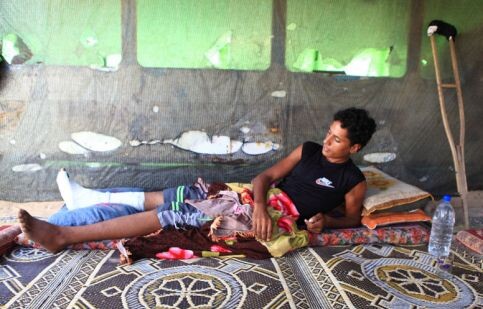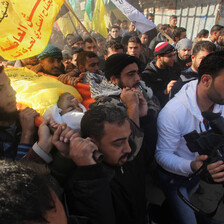The Electronic Intifada 20 October 2010

A Palestinian teenager shot in the ankle while scavenging for building material, October 2010. (Anne Paq/ActiveStills)
EREZ CROSSING, occupied Gaza Strip (IPS) - Crossing through the metal-caged tunnel that leads from the Israeli side of the boundary into northern Gaza towards the Palestinian checkpoint, several groups of young Palestinian men and boys can be seen scavenging through piles of rubble.
The twisted metal and shattered concrete are all that remain of Palestinian homes bombed and shelled by the Israel military during its invasion of Gaza from December 2008 to January 2009 dubbed “Operation Cast Lead.”
Suddenly several shots ring out. The fire comes from Israeli military guard towers and is aimed at the youngsters about a hundred meters away. Israel has declared a 300-meter security zone between the Gaza boundary fence and northern Gaza.
Since the end of Cast Lead at least 25 Gazans, six of them children, have been killed by Israeli gunfire in the buffer zone. Another 146 have been wounded.
Defence for Children International reports that ten young Palestinians have been shot in the past three months. The youngest was 13 and the oldest 17. Three horses and a donkey were also shot dead.
According to the UN Office for the Coordination of Humanitarian Affairs (OCHA) “uncertainty and lack of clarity are high regarding the precise boundaries of the restricted areas, the conditions under which access to these areas may be allowed or denied, and the consequences of a prohibited entry.
“Regarding the boundaries, the Israeli military has failed to physically demarcate the restricted areas in any meaningful way, even though it carries out land incursions into the restricted areas three to four times every week.”
Karl Shembri from Oxfam in Gaza tells IPS, “besides farmers who are banned from working on their land accounting for more than 30 percent of Gaza’s highly fertile soil, Israeli soldiers also shoot at Palestinians collecting rubble to be recycled for reconstruction from up to 1,500 meters from the fence, at times fatally.
“Not only are Palestinians denied construction material, they are shot at when trying to make up for the devastating shortage by recycling what’s left of their destroyed houses and factories,” adds Schembri. The Israeli rights group Gisha reports that the amount of reconstruction material currently allowed into Gaza at present amounts to only four percent of what is needed. This has allowed some international aid projects such as sewage plants, water wells and community centers to be built. But most Palestinian homes and businesses remain either damaged or destroyed.
The UN agency for Palestine refuges, UNWRA has been forced to turn away 40,000 Gaza children eligible to enroll in its schools for this academic year because it has been unable to build 100 new schools to meet enrollment demands. The shortage of classrooms has forced most of Gaza’s schools to hold double shifts in classes accommodating up to fifty students.
OCHA reports that since June 2009, a total of 46 percent of agricultural land in the Gaza Strip was assessed to be inaccessible or out of production owing to destruction of land during “Cast Lead” and inaccessible areas lying within the “security buffer zone.”
The area inside the buffer zone along the northern and eastern boundary with Israel contains nearly a third of the Gaza Strip’s arable land, and is inaccessible to farmers and herders.
IPS has regularly witnessed the boys working near the border. Many of those shot in this belt were wounded in the legs or arms in what appeared to be a warning.
Such is the grinding poverty and unemployment in Gaza, with 80 percent of the population dependent on food aid, that these youngsters regularly risk life and limb to earn what by Gaza standards is a good income.
A day’s backbreaking work from dawn until sunset salvaging through rubble can net about $40. Both scrap metal and rubble are collected. Some of the collection sites are in the buffer zone.
Most commonly, chunks of concrete rubble are unearthed and ground down, and then remixed to make poor grade bricks which are then sold to contractors and factories. Because rubble-collecting is relatively lucrative, an increasingly large number of Palestinians in Gaza are venturing into buffer zones.
All rights reserved, IPS - Inter Press Service (2010). Total or partial publication, retransmission or sale forbidden.





